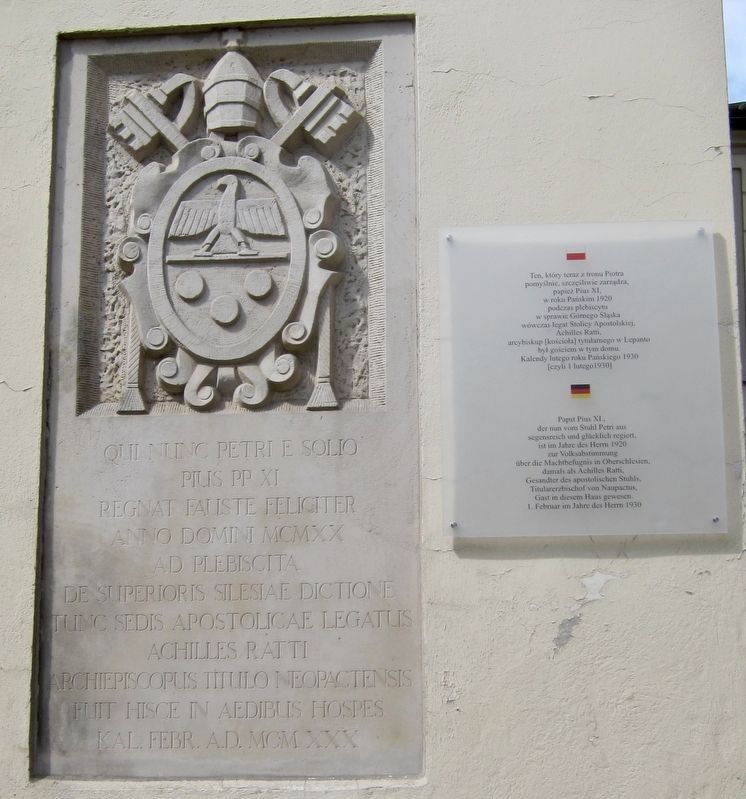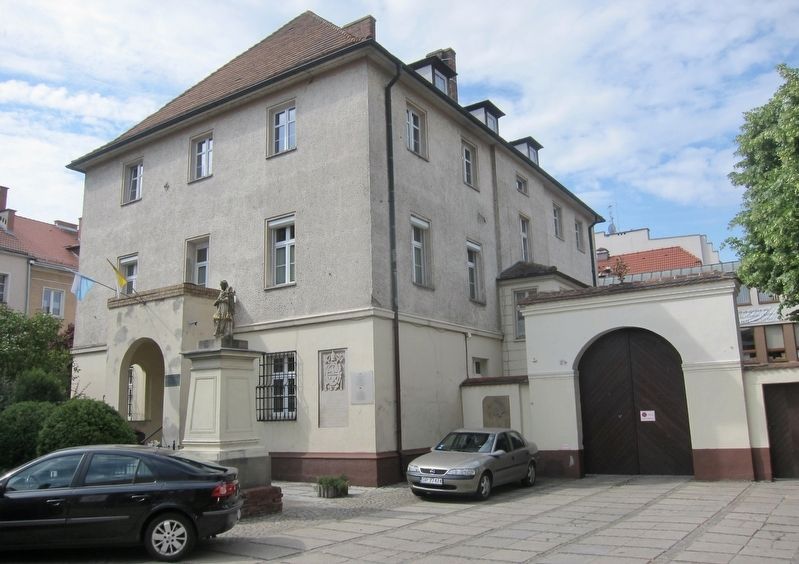Pope Pius XI
(Left tablet, Latin text:)
Pope Pius XI, who now rules in blessedness and felicity from the Holy See of Peter, was a guest in this House in the Year of Our Lord 1920 for the plebiscite on the authority in Upper Silesia, then as Achilles Ratti (Pius XI's given name), Ambassador of the Apostolic See and Titular Archbishop of Naupactus (Lepanto). The 1st of February in the Year of Our Lord 1930
Pius PP XI
regnat fauste feliciter
Anno Domini MCMXX
ad plebiscita
de Superioris Silesiae dictione
tunc sedis apostolicae legatus
Achilles Ratti
Archiepiscopus titulo Neopactensis
fuit hisce in aedibus hospes
Kal. Febr. A.D. MCMXXX
pomyślnie, szczęśliwie zarządza,
papież Pius XI,
w roku Pańskim 1920
podczas plebiscytu
w sprawie Górnego Śląska
wówczas legat Stolicy Apostolskiej,
Achilles Ratti,
arcybiskup [kościoła] tytularnego w Lepanto
był gościem w tym domu.
Kalendy lutego roku Pańskiego 1930
[czyli 1 lutego 1930]
der nun vom Stuhl Petri aus
segensreich und glücklich regiert,
ist im Jahre des Herrn 1920
zur Volksabstimmung
über die Machtbefugnis
in Oberschlesien,
damals als Achilles Ratti,
Gesandter des apostolischen Stuhls,
Titularerzbischof von Naupactus,
Gast in diesem Haus gewesen.
1. Februar im Jahre des Herrn 1930
Erected 1930.
Topics. This historical marker is listed in these topic lists: Churches & Religion • Government & Politics. A significant historical year for this entry is 1920.
Location. 50° 40.213′ N, 17° 55.258′ E. Marker is in Opole, Opolskie (Opole), in Opole Powiat. Marker can be reached from the intersection of Katedralna and Książąt Opolskich. Touch for map. Marker is at or near this postal address: Katedralna 1, Opole, Opolskie 45-007, Poland. Touch for directions.
Other nearby markers. At least 8 other markers are within walking distance of this marker. Holy Cross Cathedral (within shouting distance of this marker); Bronisław Koraszewski (about 90 meters away, measured in a direct line); Dawny Zajazd Pocztowy / Ehemaliger Gasthof / The Old Post Inn
Also see . . .
1. Pope Pius XI (Wikipedia). "...After Pope Benedict sent Ratti to Silesia to forestall potential political agitation within the Polish Catholic clergy, the nuncio was asked to leave Poland. On 20 November, when German Cardinal Adolf Bertram announced a papal ban on all political activities of clergymen, calls for Ratti's expulsion climaxed. Ratti was asked to leave. “While he tried honestly to show himself as a friend of Poland, Warsaw forced his departure, after his neutrality in Silesian voting was questioned” by Germans and Poles. Nationalistic Germans objected to the Polish nuncio supervising local elections, and patriotic Poles were upset because
he curtailed political action among the clergy." (Submitted on June 4, 2018.)
2. Upper Silesia plebiscite (Wikipedia). "The Upper Silesia plebiscite was a plebiscite mandated by the Versailles Treaty and carried out on 20 March 1921 to determine a section of the border between Weimar Germany and Poland. The region was ethnically mixed with both Germans and Poles; according to prewar statistics, ethnic Poles formed 60 percent of the population. Under the previous rule by the German Empire, Poles claimed they had faced discrimination, making them effectively second class citizens. The period of the plebiscite campaign and inter-Allied occupation was marked by violence. There were three Polish uprisings, and German volunteer paramilitary units came to the region as well." (Submitted on June 4, 2018.)
Credits. This page was last revised on June 4, 2018. It was originally submitted on June 4, 2018, by Andrew Ruppenstein of Lamorinda, California. This page has been viewed 177 times since then and 10 times this year. Photos: 1, 2. submitted on June 4, 2018, by Andrew Ruppenstein of Lamorinda, California.

